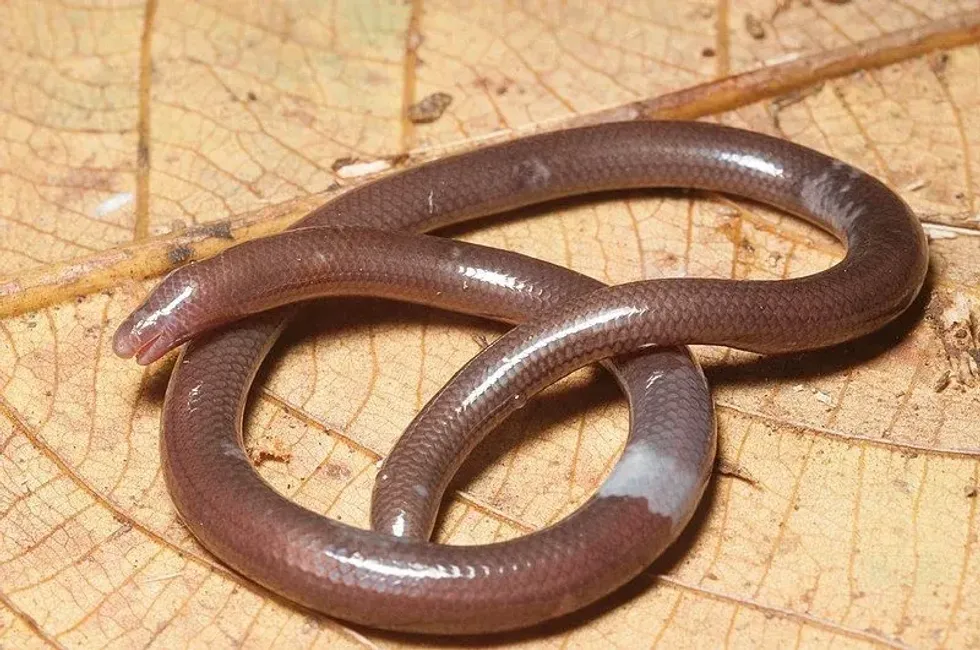A family of lizards known for its elongated cylindrical body, the Dibamidae is also known as blind skinks. The family comprises two genera, Dibamus and Anelytropsis, that consist of 24 species. The family Dibamidae is known as the sister group of lizards and snakes.
The blind lizards are found in Mexico, western New Guinea, and several countries of Southeast Asia such as Indonesia, the Philippines. Dibamids majorly dwell in the late seral forest, woodland areas, and deserts.
The elongated bodies of the lizards possess a blunt head, tail and lack limbs. These lizards are found either in dark brown or purple color.
They are quite small but can reach a maximum length of 9 in (25 cm). The species of the genus Dibamus have small tails compared to the Anelytropsis genus.
The snout-vent length of the species of Dibamus is around 2-8 in (5-20 cm), while the snout-vent length of Anelytropsis lizards is 3-7 in (8-18 cm). Also, species of the former genus have 18-33 rows of scales, while the Anelytropsis lizards have 19-25 rows of scales.
The hind limbs of these lizards are poorly developed. The males possess tibia, fibula, and femur, while females only have femur.
The blind lizards are carnivores and prey on arthropods, earthworms. Their jawbone also possesses less than 10 teeth.
The International Union for Conservation of Nature listed a few species of Dibamus and Mexican blind lizard, the only species of the Anelytropsis genus in the Least Concern category, while species such as Dibamus kondaoensis and Dibamus tiomanensis are listed in the Near Threatened category.
Keep on reading to learn more interesting facts about Dibamidae. If you want to know more exciting information about different animals, check out these articles on the coral snake and the eastern diamondback rattlesnake.
Dibamidae Interesting Facts
What type of animal is a Dibamidae?
The Dibamidae is a family of lizards. The family comprises two genera – Dibamus and Anelytropsis – that consist of 24 species. The family is known as the sister group of lizards and snakes. The dibamid generally inhabits the burrows and logs.
What class of animal does a Dibamidae belong to?
These blind skinks belong to the class of Reptilia, the second-largest order of extant vertebrates known as Squamata. There are around 10,900 species in the order.
How many Dibamidae are there in the world?
The exact population of these reptiles is not known. These legless lizards are quite rare and the population of a few species is constantly declining.
Where does a Dibamidae live?
The blind lizards are found in western New Guinea, and several countries of Southeast Asia such as Indonesia, the Philippines. These lizards can also be spotted in a few countries of North America like Mexico. Studies also reveal that these lizards migrated to North America from Southeast Asia during the late Cretaceous period.
What is a Dibamidae's habitat?
The dibamids are identified by their burrowing habits. They generally dig burrows or dwell in old burrows to survive. The leaf litter or logs also serve as their habitat. The species of the Dibamus genus are found in the late seral forest, woodland areas while the Mexican blind lizard of the Anelytropsis genus dwells in deserts or xeric conditions.
Who do Dibamidae live with?
Very little information regarding social behavior is available as of now but like other species of lizards, the dibamids are believed to solitary animals. These lizards form pairs during the breeding season. During the winter season, they generally hibernate alone in burrows and venture out during the summer season.
How long does a Dibamidae live?
The exact lifespan of these reptiles is not known but species of skinks generally live up to two to four years. Species living in captivity can live for around six years.
How do they reproduce?
Information regarding the mating pattern is not available but it is said that these skinks have similar mating patterns, like other species. The breeding season is not known but they generally mate after the hibernation period. Also, males generally form pairs with females of the same home range.
These lizards reach sexual maturity after one year of age. Most of the skink species are polygynandrous, which means males and females mate with multiple partners in a breeding season. The tongues of male skinks give chemical signals – they flicker to find potential mates.
Males are involved in competitions and fights. They bite each other to establish dominance. Compared to smaller males, larger males are more successful to mate with females.
After mating, males usually leave and find other potential partners. Females generally lay a single egg with a hardened shell. Also, no parent investment is involved. Studies reveal that the species of the Dibamus genus frequently lay eggs, unlike the Mexican blind lizard of the Anelytropsis genus.
What is their conservation status?
The International Union for Conservation of Nature listed a few species of Dibamus and Mexican blind lizard, the only species of the Anelytropsis genus, in the Least Concern category. However, species such as Dibamus kondaoensis and Dibamus tiomanensis are listed in the Near Threatened category.
The Convention on International Trade in Endangered Species of Wild Fauna and Flora or CITES has not listed any of the species as Endangered species. Loss of habitat and predation are a few major threats to dibamids.
Dibamidae Fun Facts
What do Dibamidae look like?
Generally, the species of the Dibamidae family are found either in dark brown or purple variants, but the Mexican blind lizard possesses a pale pink body with shiny and smooth scales. The lizard lack limbs and the elongated body has a blunt head and tail.
Unlike other species of skinks, the Mexican blind lizards have no external ears and even their eyes are covered with scales. The skull helps to dig deep burrows while the jawbone has less than 10 teeth.
How cute are they?
The Dibamidae species are considered very cute and adorable. Due to their small size, you can hold these lizards quite easily. Unlike most of the lizards, these skinks are good with humans.
How do they communicate?
No information regarding their communication methods is available as of now, but it is believed that like other skink species, the dibamids use several chemical signals to communicate. Males generally use their tongues to identify potential partners.
Several species of skink possess a vomeronasal organ that helps the males to pick out sexually receptive and non-receptive females. They are quite territorial and aggressive towards other males. The chemical cues also help them to locate prey and predator.
How big is a Dibamidae?
The dibamids are quite small but can reach a maximum length of 9 in (25 cm). The species of the genus Dibamus have small tails compared to the Anelytropsis genus.
The snout-vent length of the species of Dibamus is around 2-8 in (5-20 cm) while the SVL of Anelytropsis lizards is 3-7 in (8-18 cm). These lizards are thrice the size of dwarf salamanders and Barton Springs salamanders.
How fast can a Dibamidae move?
The exact speed of blind lizards is not known, but to avoid predation and in order to catch prey, they move quite fast. Their tails help them to avoid predation.
How much does a Dibamidae weigh?
The weight of dibamids is not known.
What are the male and female names of the species?
There are no specific names given to the male and females lizards of the Dibamidae family. Males possess small flap-live hind limbs, unlike females.
What would you call a baby Dibamidae?
No particular name is given to the babies of blind lizards.
What do they eat?
The blind lizards are carnivores and often prey on earthworms, arthropods such as centipedes, and butterflies.
Are they poisonous?
No, blind lizards are not venomous or poisonous and do not pose any threats to humans. However, they have teeth and can bite if someone tries to provoke them. Also, these lizards carry a bacteria known as Salmonella that can cause serious sickness to humans. The bacteria spread by contact with amphibians and reptiles.
Would they make a good pet?
People generally consider several species of skinks as pets as they are quite friendly and easy to tame. They easily get accustomed to man-made habitats.
If proper maintenance and hygiene are maintained, these lizards could survive more years than usual. But the population of many species of the Dimadae family is declining, so keeping them as pets might not be allowed in some countries.
Did you know...
The largest surviving skink species, the Solomon Islands skink could reach a length of 32 in (81 cm) while the little brown skink is the smallest extant species. The average length of the species is around 3 in (7.5 cm).
Are Dibamidae blind?
Yes, the species of the Dibamidae family are blind and their eyes are covered with scales, hence, they are also known as blind skinks. These blind lizards even lack limbs and palatal teeth, but their tongues help them to communicate. The tongues of male skinks give chemical signals and they flicker to find potential mates.
Types of Dibamidae
The family comprises two genera, Dibamus and Anelytropsis, that consist of 24 species. The Anelytropsis is monotypic and the Mexican blind lizard is the only species of the genus.
Alfred's blind skink, Bogadek's burrowing lizard, Boo Liat's blind lizard, Flowers' blind lizard, white blind skink, Smith's blind skink, and Somsak's blind lizard are a few species of the Dibamus genus.
The species of the genus Dibamus have small tails compared to the Anelytropsis genus. The snout-vent length of the species of Dibamus is around 2-8 in (5-20 cm) while the SVL of Anelytropsis lizards is 3-7 in (8-18 cm). Also, species of the former genus have 18-33 rows of scales, while the Anelytropsis lizards have 19-25 rows of scales.
The species of the Dibamus genus are found in the late seral forest, woodland areas, while the Mexican blind lizard of the Anelytropsis genus dwells in deserts or xeric conditions. The blind lizards are found in western New Guinea, and several countries of Southeast Asia such as Indonesia, the Philippines.
These lizards can also be spotted in a few countries of North America like Mexico. Studies also reveal that these lizards migrated to North America from Southeast Asia during the late Cretaceous period.
Fossils from the final epoch of the Paleogene period of the Valley of Lakes in Central Mongolia suggest that the extinct monotypic genus Hoeckosaurus belonged to the Dibamidae family.
Here at Kidadl, we have carefully created lots of interesting family-friendly animal facts for everyone to discover! Learn more about some other reptiles from our reticulated python facts and gopher snake facts pages.
You can even occupy yourself at home by coloring in one of our free printable angry snake coloring pages.










